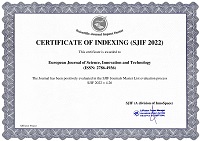Comparative Study on the Production of Upland Rice (Oryza sativa) Grown in Kindu Varieties: KISASA, ONU, MOMBE and DIMENA, Lwama I Site
Abstract
The experiment was carried out in the DRC in the province of Maniema, city of Kindu, more precisely in the university site Lwama I. The general objective of this study was to conduct a comparative study on the production of upland rice (Oryza sativa) grown in Kindu in the case of the varieties: KISASA, ONU, MOMBE and DIMENA, Lwama I site. Indeed, it had the following specific objectives: to determine the growth-related behaviors of each variety studied, and to compare the production level of the varieties studied.
In the course of this study, the hypotheses were put forward: (a) The varieties of rainfed rice farmed in Kindu are said to have different behaviors related to growth, and (b) There are reportedly productive varieties of upland rice in the city of Kindu. To achieve this, we conducted a field experiment with a randomized complete block device with 4 treatments and 4 replicates.
The following results were obtained: (1) For the emergence rate, the ONU variety was the best with 79.33% followed by the DIMENA variety with 60.45%; (2) For tillering, the UN variety 36 tillers followed by the MOMBE variety with 14 tillers; (3) For the diameter at the collar, the ONU variety was the best with 3.40cm followed by the MOMBE variety with 2.69cm; (4) For the height of the plants, the variety DIMENA obtained the high height with 74.27cm followed by the variety MOMBE with 51.55cm; (5) For the number of grains per panicle, KISASA was the best with 209.91 followed by the DIMENA variety with 199.41; (6) For grain weight per plot, the MOMBE variety was better with 1.93. The highest yield was observed in T1 (DIMENA) with 835.64 Kg/ha and the lowest yield is 678.12 Kg/ha observed in T4 (KISASA). The average is 721.8 Kg/h. Statistically, no variety was superior to the other in terms of yield.
At the end of this study, we say that our hypotheses have been verified and our objectives have been achieved. To do this, we suggest the following: (1) It is up to the growers to use the DIMENA variety which was better in this study followed by the KISASA variety whose yield was satisfactory; (2) It is up to the researchers to deepen this study in order to address the other aspects that have not been covered.
References
Emongo (2014). Influence of organic fertilizers on rice grown in the province of Maniema, because of the NERICA 3, NERICA 4, GHANA RICE varieties. Cultivated under ecological conditions in the WASONGOLA sector in the LOKONGO village. Unpublished memory.
Mansy (2014). Phytosanitary sheet for rice and sugar cane. Reunion Island. P3. Available on www.bsv-reunion.fr.
Mbodj (1991). Rainfed rice farming in Casamance; situation in 1991. Document ISRA Djibelor, p. 22.
Ngama (2018). Special phytopathology course. Kindu UNIKI Ist grade university. Unpublished course.
Rawal (1975). Varietal catalog of food crops. Kinshasa.p42. Misenga, 2014: statistics and biometrics course. University of Kindu UNIKI. FSA I grade. Unpublished course.
Copyright (c) 2024 Adiyo Sumbu Henriette, Sosthenes Kitaby

This work is licensed under a Creative Commons Attribution 4.0 International License.


 ISSN
ISSN 











